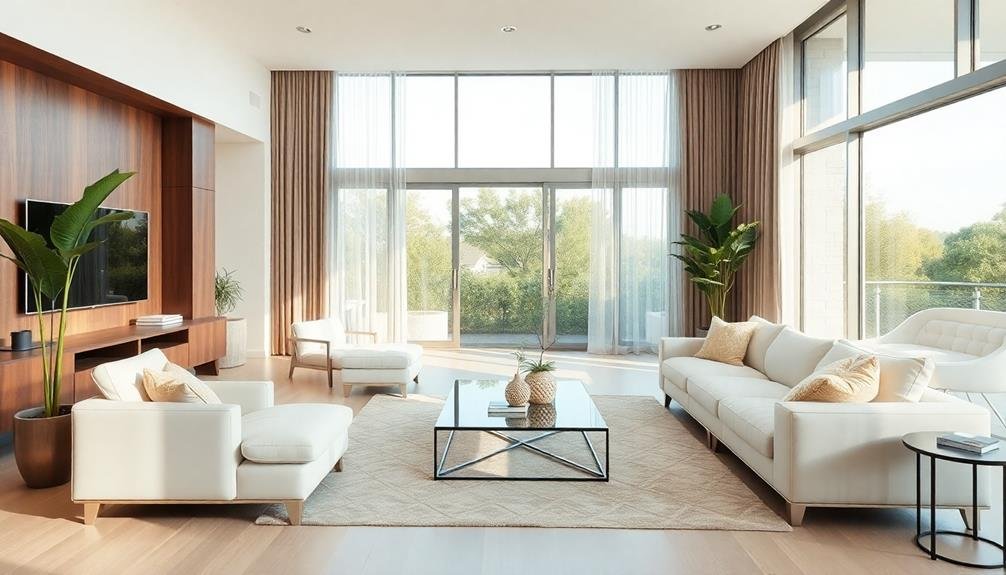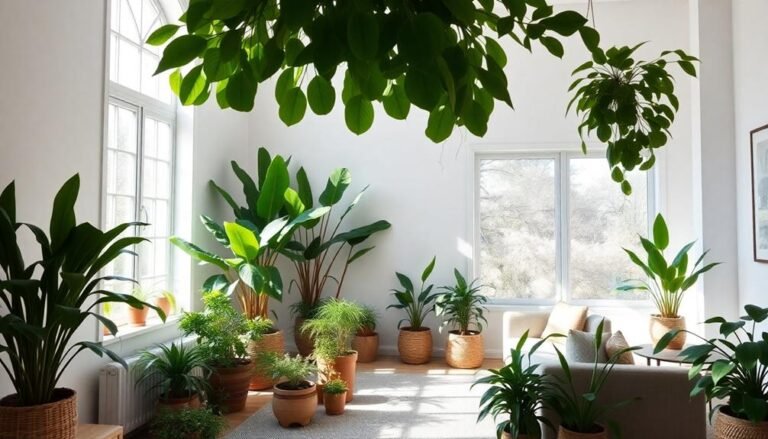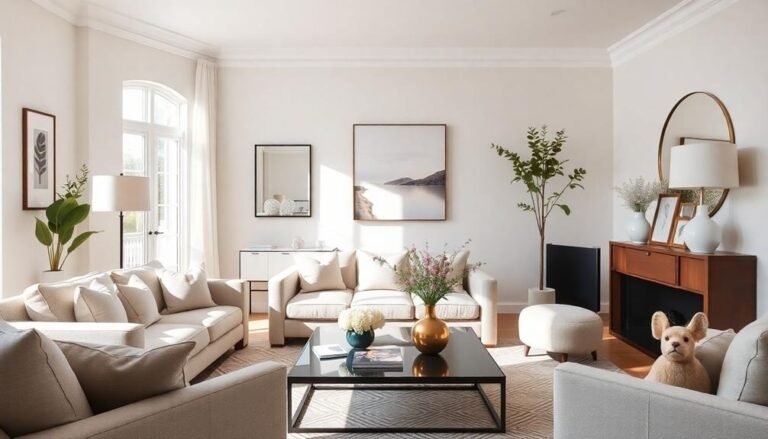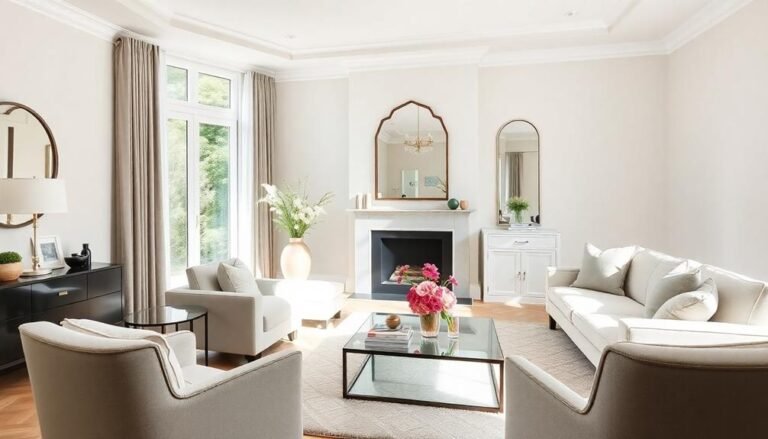To stage a clean, open space with minimalist decor, start by embracing neutral color palettes that create a serene backdrop. Declutter your area, keeping only essential items and limiting decorative accessories to three per surface for an inviting feel. Choose functional furniture that serves multiple purposes, like a stylish storage bench or a sofa bed. Utilize natural light by choosing light window treatments and arranging furniture to maximize brightness. Don't forget to incorporate various textures for depth, and use rugs to define spaces. This approach promotes clarity and calm, setting the stage for an inviting environment. You'll discover even more effective strategies shortly.
Embrace Neutral Color Palettes
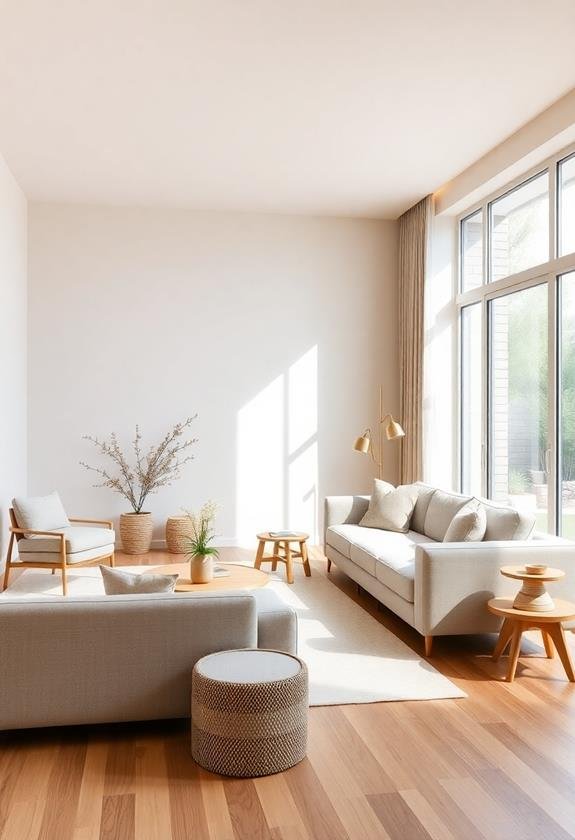
Embracing a neutral color palette creates a sense of calm and balance in your space. By opting for shades like beige, gray, and white, you invite serenity and simplicity into your home. These colors provide a versatile backdrop that allows your furnishings and decor to shine without overwhelming the senses. When you choose a neutral palette, you're not just making a design choice; you're creating an inviting atmosphere that promotes relaxation. Incorporating trending home decor items can enhance this aesthetic while ensuring your space feels updated and cohesive.
Incorporating texture is vital when working with neutral tones. Consider mixing materials like wood, metal, and fabric to add depth and interest to your space. For instance, a soft, beige sofa paired with a sleek, metallic coffee table can create a stunning contrast that draws the eye. Additionally, you can enhance the ambiance by using varying shades of the same color, which can help define areas within an open floor plan.
Don't underestimate the power of natural light either; it plays an important role in how neutral colors appear in your environment. By strategically placing mirrors or light-colored curtains, you can amplify the brightness of your space, making it feel even more open and airy. This approach not only beautifies your home but also nurtures a peaceful living experience.
Declutter and Simplify
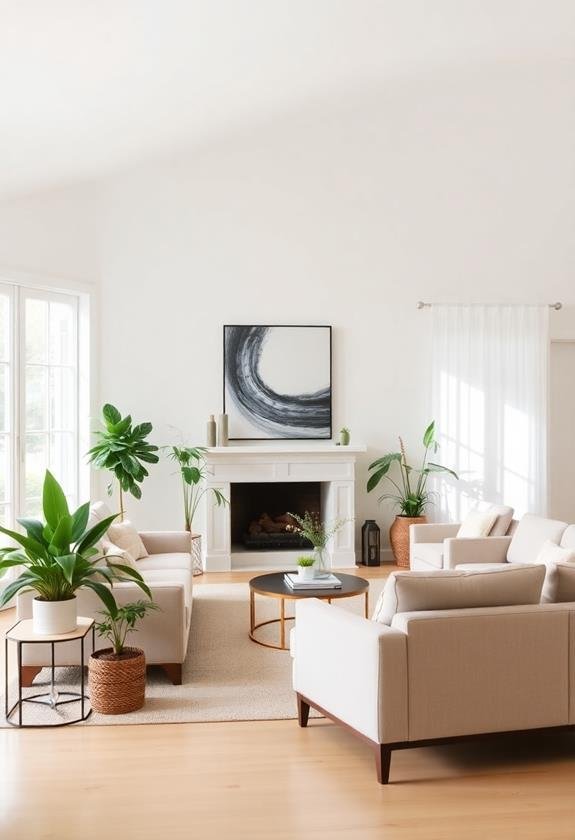
Decluttering and simplifying your space is essential for achieving a minimalist aesthetic. Start by evaluating your belongings; ask yourself if each item serves a purpose or brings you joy. If it doesn't, consider donating or discarding it. Focus on one area at a time, whether it's a room or a specific surface like a countertop. This approach prevents feeling overwhelmed and allows you to see progress more clearly. Incorporating eco-friendly storage solutions into your organization can enhance your minimalist decor while also promoting sustainability.
Next, tackle storage solutions. Utilize boxes, baskets, or bins to organize items you choose to keep, ensuring they're easily accessible yet out of sight. This way, you maintain a clean surface while still having your important items on hand.
Be mindful of surfaces in your home; they tend to accumulate clutter. Keep them as clear as possible. A few carefully chosen decor pieces are far more impactful than a multitude of items that compete for attention.
Lastly, develop a routine for maintaining your space. Regularly evaluate your belongings and remove unnecessary items to prevent clutter from returning. By committing to this process, you'll create a serene environment that embodies the minimalist ideal, making your home feel more inviting and spacious.
Choose Functional Furniture
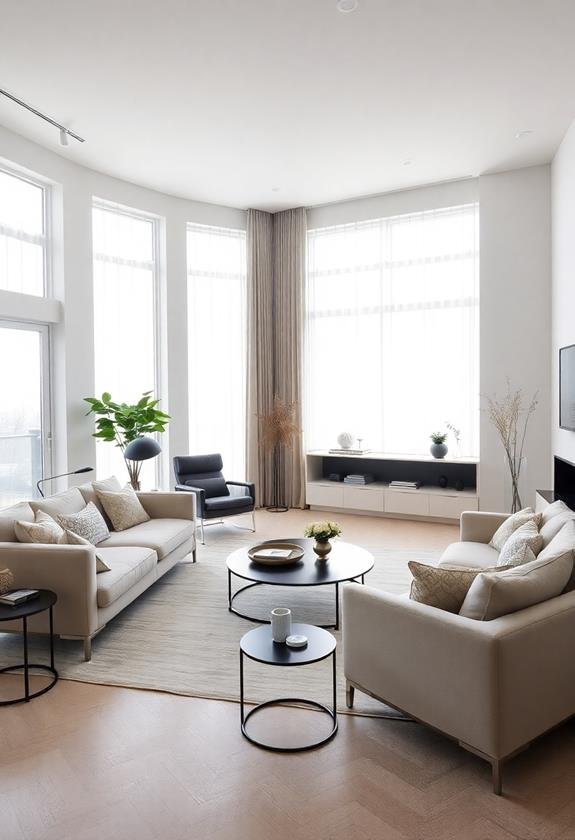
Functional furniture is key to achieving a minimalist decor that maximizes space and utility. When you choose pieces that serve multiple purposes, such as stylish storage benches, you not only enhance your space but also maintain a clean and open atmosphere. For instance, consider a coffee table with built-in storage. It allows you to keep your living area tidy by hiding away items that might otherwise clutter the surface. Top stylish storage benches are designed to provide both seating and organization, making them an excellent addition to any minimalist space.
Another great option is a sofa bed. This versatile piece transforms your living room into a guest room effortlessly, accommodating visitors without sacrificing style or comfort. Additionally, look for foldable or stackable chairs that can be easily stored when not in use. They provide extra seating for gatherings without overwhelming your space.
When selecting functional furniture, prioritize quality over quantity. Investing in fewer, high-quality pieces guarantees durability and a cohesive aesthetic. Aim for furniture with clean lines and neutral colors, as these attributes contribute to a serene environment.
Utilize Natural Light
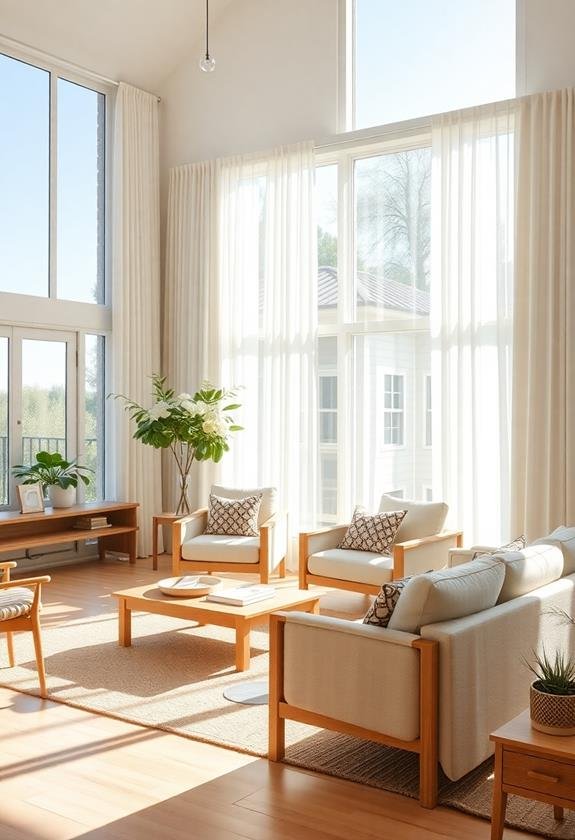
Maximizing natural light is essential for creating an airy, open feel in your minimalist space. Start by choosing window treatments that allow light to flood in. Opt for sheer curtains or blinds that can be pulled completely back during the day. This simple adjustment can greatly brighten your room, enhancing its spaciousness.
You should also consider the layout of your furniture. Position larger pieces away from windows to prevent obstructing light. If possible, arrange seating to face windows, inviting sunlight into your space while creating a welcoming atmosphere. Mirrors can be a valuable addition, too; they reflect light and make your area feel larger. Placing a mirror opposite a window can double the amount of natural light bouncing around the room.
Furthermore, keep your color palette light and neutral, as these hues reflect rather than absorb light. White walls or soft pastels can amplify sunlight, making your space feel even more open and inviting. Finally, remember to maintain a clutter-free environment, as a tidy space allows light to flow freely, enhancing the minimalist aesthetic you aim for. By thoughtfully utilizing natural light, you'll create a serene and spacious atmosphere that feels both modern and inviting.
Incorporate Textures and Materials
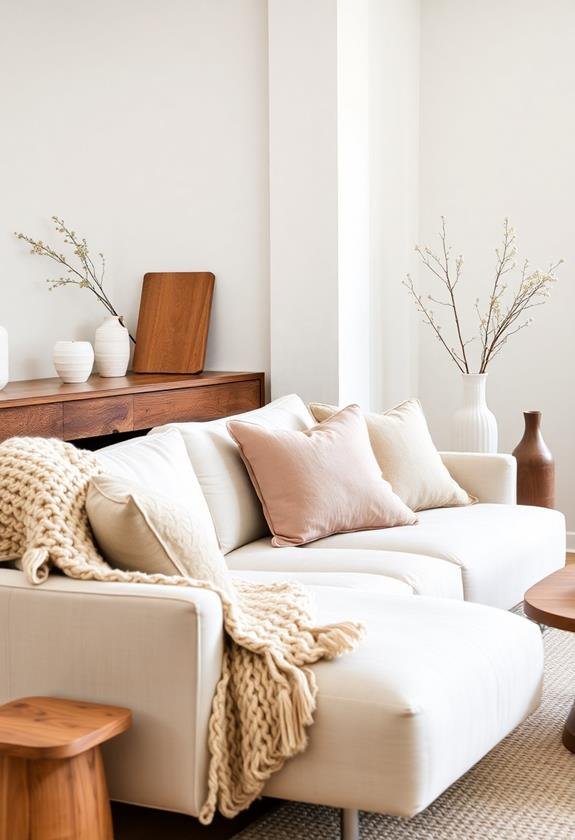
Bringing in natural light sets the stage for a minimalist space, but it's the textures and materials that truly elevate the design. To create an inviting atmosphere, consider incorporating a variety of textures, such as soft textiles, smooth ceramics, or rustic wood. These elements not only add depth but also encourage a tactile experience that makes your space feel warm and welcoming.
For instance, a plush wool rug can contrast beautifully with sleek, modern furniture, while linen curtains soften harsh lines and introduce a gentle flow. You might also choose a statement piece, like a handcrafted coffee table, that showcases unique grains or finishes, adding a touch of character without overwhelming the room.
Don't forget about color; subtle variations in tone can enhance the overall aesthetic. Neutral palettes work well, but introducing a single bold texture—like a vibrant velvet cushion—can create a focal point that draws the eye.
Ultimately, it's about balance. By thoughtfully combining different materials, you can maintain a minimalist vibe while ensuring your space feels rich and engaging. This approach not only reflects your personality but also invites others to appreciate the beauty in simplicity.
Limit Decorative Accessories
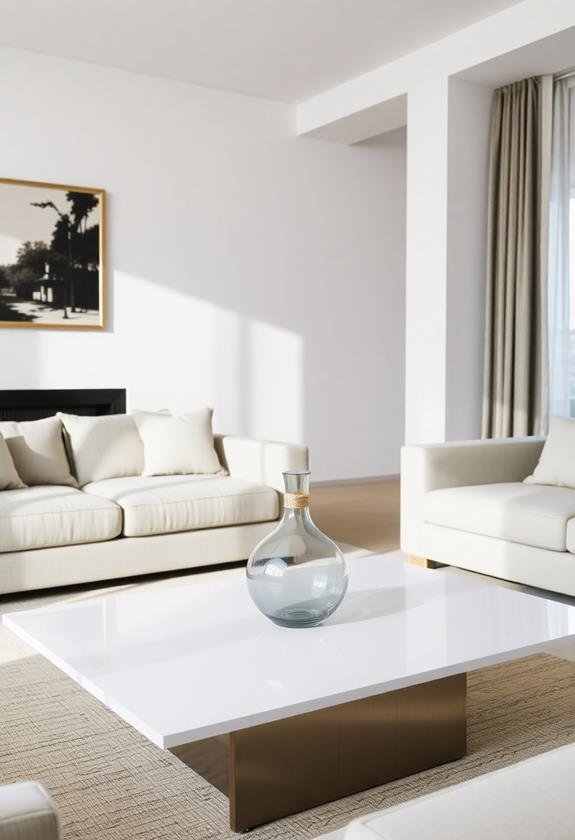
How can you create an inviting minimalist space without overwhelming it with clutter? One of the best ways is to limit decorative accessories. Instead of filling every available surface with knickknacks, choose a few carefully selected pieces that truly resonate with you. This approach not only maintains a clean aesthetic but also allows your chosen items to stand out, drawing attention rather than blending into a chaotic backdrop.
Start by evaluating your existing decor. Ask yourself if each item serves a purpose or brings joy. If it doesn't, consider removing it. Aim for a maximum of three decorative accessories on any given surface, like a coffee table or shelf. This rule helps maintain focus and guarantees that each piece contributes to the overall ambiance.
Additionally, opt for accessories that incorporate natural elements, such as a single potted plant or a textured vase. These choices add warmth without overcrowding your space. Remember, less is often more in minimalist design. By limiting decorative accessories, you'll create a serene environment that feels open and inviting, encouraging relaxation and clarity in your home.
Create Defined Spaces
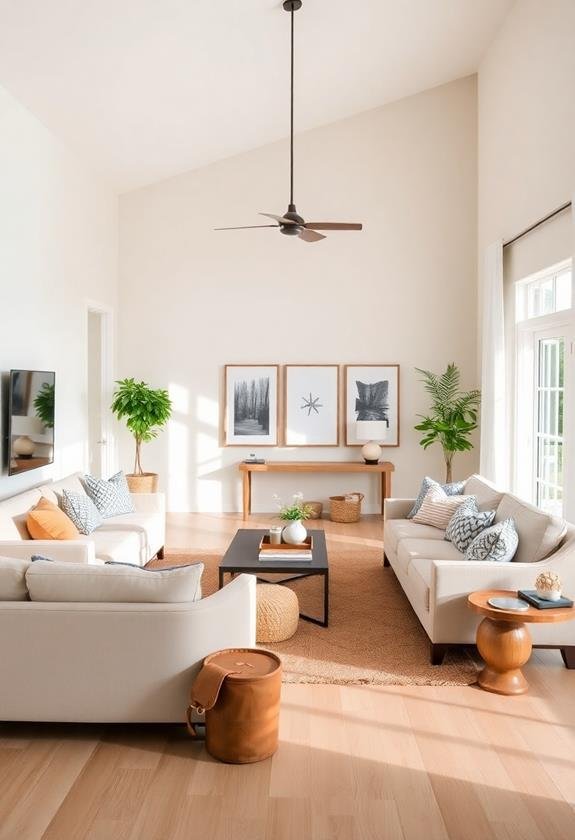
Creating defined spaces within your home can greatly enhance the minimalist vibe you're aiming for. By clearly outlining different areas, you can maintain an open and airy atmosphere while ensuring each zone serves its purpose. Start by using furniture placement as a tool; for instance, position a sofa to create a cozy living area, or place a desk in a corner to designate a workspace.
Additionally, consider using rugs to visually separate areas, making it easier for guests to understand the flow of your home. A large area rug can anchor a seating arrangement, while smaller rugs can define entryways or dining spaces. You might also utilize lighting to delineate spaces—hanging pendant lights over a dining table can create a focal point while subtly indicating where eating occurs.
Incorporating plants or decorative screens can further enhance these defined spaces without overwhelming your decor. Remember, the goal is to achieve balance; you want to avoid clutter while still allowing each area to feel inviting and functional. By thoughtfully defining spaces, you'll foster a sense of order, making your home feel more peaceful and organized.
Frequently Asked Questions
How Do I Choose the Right Neutral Color for My Space?
Choosing the right neutral color for your space can feel like picking the perfect canvas for a masterpiece. Start by considering the natural light; warm hues like beige or taupe can create a cozy atmosphere, while cooler shades like gray offer a modern touch. Test samples on your walls to see how they change throughout the day. Remember, the right color sets the mood, so choose one that reflects your style and enhances your space.
What Are Some Effective Decluttering Methods to Try?
To effectively declutter your space, start by applying the "one in, one out" rule; whenever you bring in a new item, let go of an old one. You can also tackle categories—like clothes or books—by sorting them into keep, donate, or discard piles. Set a timer for short bursts of focused decluttering; this helps you stay motivated. Finally, consider storage solutions that keep frequently used items accessible while hiding away less essential ones.
Can I Mix Different Textures in a Minimalist Design?
Sure, you can mix different textures in a minimalist design. It's not a crime to add a cozy throw or a sleek metal accent; in fact, it enhances visual interest. Think about contrasting materials—smooth glass paired with rough wood, for instance. This combination creates depth without cluttering your space. Just remember, balance is key; too many textures can overwhelm, so keep it simple, yet inviting. Your minimalist sanctuary can still feel warm and engaging!
How Can I Maximize Natural Light in a Small Room?
To maximize natural light in a small room, start by using light-colored paint on the walls, which reflects light effectively. Position mirrors opposite windows to create an illusion of depth and brightness. Opt for sheer curtains instead of heavy drapes, allowing sunlight to filter through. You might also consider strategically placing furniture away from windows, ensuring nothing obstructs the flow of light. Finally, keep window areas clear of clutter to invite more natural illumination.
What Types of Functional Furniture Are Best for Small Spaces?
When it comes to small spaces, you might think you can't have stylish, functional furniture, but that's not true. Look for pieces like a sofa bed or an ottoman with storage; they serve multiple purposes without overwhelming your room. Nesting tables can fit into tight spots and expand when needed. Consider wall-mounted shelves for added storage that doesn't take up floor space. By choosing wisely, you can achieve both comfort and functionality seamlessly.

